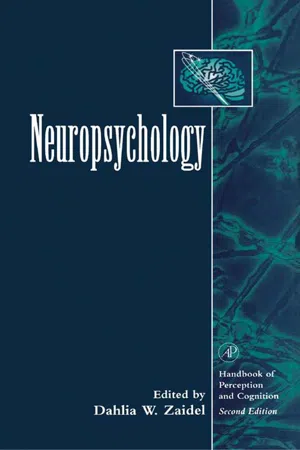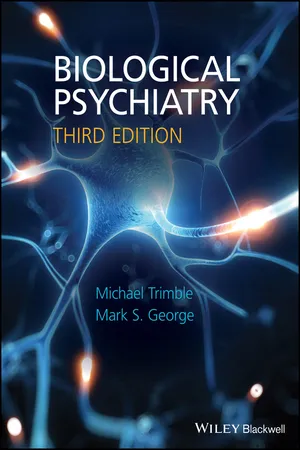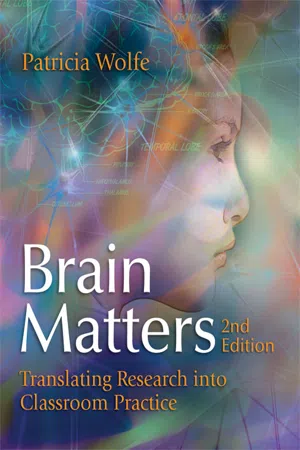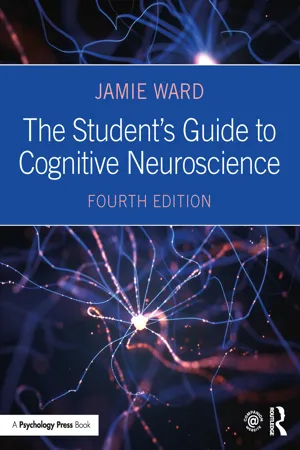Psychology
Brain Structure
The brain structure refers to the physical arrangement of the brain's components, including the cerebral cortex, cerebellum, and brainstem. These components are responsible for various functions such as cognition, emotion, and motor control. Understanding brain structure is crucial in studying how different areas of the brain contribute to behavior, thoughts, and emotions.
Written by Perlego with AI-assistance
7 Key excerpts on "Brain Structure"
Learn about this page
Index pages curate the most relevant extracts from our library of academic textbooks. They’ve been created using an in-house natural language model (NLM), each adding context and meaning to key research topics.
- eBook - ePub
- Milton J. Dehn(Author)
- 2013(Publication Date)
- Wiley(Publisher)
Three The Neuroanatomy of Psychological ProcessesThe purpose of this chapter is to provide an overview of the Brain Structures and functions involved in each of the 11 processes discussed in Chapter 2. Knowing some basics about the neuroanatomy of psychological processes can enhance our understanding of how brain-based processes influence learning and how dysfunctions or deficits in specific neuropsychological processes can impair specific types of learning and performance. Neuroanatomy also illustrates how and why some psychological processes are interrelated. For example, impairment in a visual pathway that connects the occipital and temporal lobes may account for a deficit in rapid automatic naming, a task that appears to depend only on memory processes.The human brain is incredibly complex, and much of its functioning is not fully understood. Some of the 11 processes can be more readily mapped to specific brain regions and structures than others. However, most brain-processing relationships involve interrelated brain networks; very few specific processes function in just one Brain Structure. This chapter will not review all brain anatomy or all types of processing but focus only on the 11 processes and the primary Brain Structures involved in these specific processes. (For more details on brain anatomy, see Carter, Aldridge, Page, & Parker, 2009; Hale & Fiorello, 2004; Reynolds & Fletcher-Janzen, 1997.)Overview of Brain Structures and Functions Related to Specific Processes
Brain Cells
The brain's nerve cells, known as neurons , make up less than 10% of the brain's volume. The remaining cells, known as glial cells , are support cells that provide such functions as supplying the neurons with glucose. What allows the brain to function as an integrated whole is the ability of each neuron to send and receive signals with countless neurons. Signals are sent out from a neuron on a long, thin extension known as the axon . Receiving the signals are numerous, shorter extensions known as dendrites . The axons and dendrites exchange signals across a small gap known as a synapse . Most growth in brain size after birth results from myelination - eBook - ePub
Psychological Criminology
An Integrative Approach
- Richard Wortley(Author)
- 2011(Publication Date)
- Willan(Publisher)
Examined in this chapter is the pivotal role in criminal behaviour played by the brain as it mediates between internal biological inputs and external environmental inputs. The area of psychology concerned with Brain Structure and function is neuropsychology. Neuropsychologists examine the biological events in the brain that underlie human action, emotion and thought, including those associated with criminal behaviour. They are concerned with both normal Brain Structures and functions, and with the behavioural implications of brain impairments. We begin with an overview of the general field of neuropsychology, before moving to a more specific discussion of neuropsychological correlates and explanations of criminal behaviour.Basic Brain Structures and FunctionsNeuropsychology, like behavioural genetics, is a specialist field and it is beyond the scope of this book to cover it in detail here. What follows, then, is a simplified description of basic Brain Structures and functions that are especially relevant to neuropsychological explanations of crime.The Nervous SystemThe brain is part of the body’s nervous system, a network of nerve cells – or neurons – that is responsible for all psychological, behavioural and physiological activity. The basic job of a neuron is to relay information. Neurons come in a variety of shapes and have different specialised functions, but most comprise four main structures. The body of the neuron is called the soma and houses the basic machinery of the cell. Extending from the soma are tree-like fibres – hundreds or even thousands in number – called dendrites, which have receptors responsible for receiving messages from other neurons. Also extending from the soma is a slender tube called an axon, which is responsible for sending messages. The axon divides and branches, and at the ends of the branches are terminal buttons from which the messages are sent. A simplified diagram of a neuron is shown in Figure 4.1.Figure 4.1A neuron.The nervous system is divided into two parts: the central nervous system (CNS) and the peripheral nervous system (PNS) (see Figure 4.2). The CNS comprises the brain and the spinal cord and is the body’s ‘command centre’. The brain receives and processes stimuli from inside and outside of the body, it interprets and stores information, and it dispatches messages to initiate responses. The spinal cord is connected to the base of the brain and primarily acts as a conduit between the brain and the rest of the body below the neck. - eBook - ePub
- Dahlia W. Zaidel(Author)
- 2013(Publication Date)
- Academic Press(Publisher)
CHAPTER 2Neuroanatomy
Brain Structure and Function
Jeffrey M. ClarkePublisher Summary
This chapter presents an introduction to different issues concerning the relationship between brain anatomy and brain function. It discusses how an understanding of anatomical–behavioral relationships begins at the microscopic level. Anatomical studies have shown that functionally distinct brain regions often exhibit striking differences in the physical characteristics of the neurons present and the pattern of connections between them. The chapter also discusses the issue of localizing functionally distinct regions of the brain. It describes the subdivisions or lobes of the brain and provides an overview of the primary functions ascribed to each region. The chapter focuses on the neocortex that comprises about 80% of the human brain and consists of the two cerebral hemispheres, the left and the right. It also describes the technological tools that provide researchers with powerful means for studying the anatomy and the physiology of the living human brain. The chapter further discusses the structure–function relationships associated with brain size and two Brain Structures, that is, the planum temporale and the corpus callosum.I INTRODUCTION
This chapter will serve as an introduction to a number of issues concerning the relationship between brain anatomy and brain function. First, I will show how an understanding of anatomical–behavioral relationships begins at the microscopic level. One may wonder how we can ever comprehend the underlying functioning of the human brain given that some 50 billion brain cells, known as neurons, are involved in information processing, and that each of these neurons can receive up to 15,000 connections from other neurons (Kolb & Whishaw, 1990 - eBook - ePub
- G Neil Martin(Author)
- 2015(Publication Date)
- Routledge(Publisher)
Some psychologists combine what seem on the surface to be entirely different branches of the discipline, such as neuroscience and social psychology. Social cognitive neuroscience, for example, involves the study of the social processes that influence behaviour, the information processing that gives rise to social behaviour and the neural basis of the cognitive behaviour that involves information processing (Ochsner and Lieberman, 2001). Some of the topics that interest social cognitive psychologists include the role of specific brain regions in socio-emotional behaviour, and the role of neural mechanisms in regulating aggression, dominance and bonding.Neuropsychology
Neuropsychology is the study of the relationship between the brain's structure and activity, and its function (Martin, 1998a). Many studies in neuropsychology are based on the consequences of human brain injury or on studies of healthy participants who are observed behaving while specialised equipment, such as brain or neuroimaging scanners, measure brain activation. The meat and drink of neuropsychology, however, is the single-case study. A psychologist will observe an impairment of function (which could be cognitive, emotional, perceptual or motoric) in a person with brain injury, and create a hypothesis about the association between the damaged brain region and the function disrupted. He or she will then administer or create another series of tests to test this hypothesis, and draw a conclusion about the significance of the underlying brain region to the disrupted function.Other methodological approaches
Psychophysiology refers to the study of the body's physiological processes and their relation to behaviour. Usually, psychophysiologists use specialised equipment (such as electrodes connected to an ECG monitor or an EEG amplifier) that records changes in the electrical activity of the body as it responds to a stimulus. Histology is the study of brain cells and their structure and activity. You will learn more about the study of cells later on in Chapter 2 - eBook - ePub
- Michael R. Trimble, Mark George(Authors)
- 2010(Publication Date)
- Wiley(Publisher)
Chapter 2 Principles of Brain Function and Structure: 2 Anatomy 2.1 IntroductionThis chapter concentrates on those areas of the brain of most importance to biological psychiatry. After a brief introduction to neuroanatomy, the limbic system, the basal ganglia, the thalamus and some important cortical areas are discussed. In the past it was common to refer to different areas of the brain using modular models. However, theories using strict localization of function to adequately explain behaviour, especially with regard to psychiatry, failed. It then became popular to consider systems, such as the limbic system, but renewing localization theories with respect to ‘systems’ would also likely fail.The most recent concepts of brain behaviour relationships have to some extent developed from the era of artificial intelligence. Although some have been led to adopt an unusual view, namely that cognition is similar in process to a computer algorithm and therefore there is no necessity to understand the hardware (i.e. the brain itself) in order to understand how the brain works and how consciousness develops, this is clearly illogical. There are indeed many differences between brains and current modern computers. While the latter are good at arithmetical computations, logical thinking and exhaustive memory searching, brains are better at pattern recognition and the use of context to interpret the whole (as in language, for example). Processing is in parallel, not in sequence, hence the development of models referred to as parallel distributed processing (PDP). As information is added to a computer, it gets slower; the exact opposite occurs with the brain.In PDP, information is no longer thought of as being represented by a sequence of numbers, but by a pattern of activation. Information is stored in connections among processing units, each with a graded activity value, a probability of firing. There is a weighted connection with other units, and it is the pattern of the activation that is relevant (Figure 2.1 - eBook - ePub
Brain Matters
Translating Research into Classroom Practice
- Patricia Wolfe(Author)
- 2010(Publication Date)
- ASCD(Publisher)
Part 1 The Structure and Function of the Human Brain The more we understand the brain, the better we'll be able to design instruction to match how it learns best. The human brain is not the largest organ in the body. It weighs only about three pounds, less than the skin covering your body. Yet this marvelous structure is the source of all human behavior, simultaneously controlling a myriad of unbelievably complex functions. Within a span of time too short for humans to measure, it receives information and relays it to the appropriate locations for processing. It then allows you to act on these data by controlling the motor output of your muscles. Your brain generates emotions and lets you be aware of them. It is the source of cognition, memory, thoughts, and what we call intelligence. Your ability to speak and understand the speech of others comes from the brain. You don't have to worry about controlling your heart rate, respiration, breathing, hormone secretion, or immune system; the brain does this for you unconsciously and automatically. In Part I of this book, we'll take a look at the major structures of the brain and the roles they play. You may be wondering why you need all this biology. Wouldn't it be sufficient just to outline the general findings about how the brain learns without understanding the structures involved? Isn't it possible to have a general understanding of research findings and perhaps even apply the findings without really comprehending what is going on in the brain? Perhaps, but I believe that if we are to become critical consumers of neuroscience and cognitive science research, or even read reports of this research in the media with any understanding, we need to have a working knowledge of the human brain. Leslie Hart, in his book Human Brain, Human Learning (1983), talks about how little sense it would make to design a device to be used by human hands without being sure that you considered the nature of hands - eBook - ePub
- Jamie Ward(Author)
- 2019(Publication Date)
- Routledge(Publisher)
Chapter 2 Introducing the brainDOI: 10.4324/9781351035187-2CONTENTS
- Structure and function of the neuron
- The gross organization of the brain
- The cerebral cortex
- The subcortex
- The midbrain and hindbrain
- Summary and key points of the chapter
- Example essay questions
- Recommended further reading
It is hard to begin a chapter about the brain without waxing lyrical. The brain is the physical organ that makes all our mental life possible. It enables us to read these words, and to consider thoughts that we have never considered before—or even to create thoughts that no human has considered before. This book will scratch the surface of how this is all possible, but the purpose of this chapter is more mundane. It offers a basic guide to the structure of the brain, starting from a description of neurons and working up to a description of how these are organized into different neuroanatomical systems. The emphasis is on the human brain rather than the brain of other species.Structure and Function of the Neuron
All neurons have basically the same structure. They consist of three components: a cell body (or soma), dendrites and an axon, as shown in Figure 2.1 . Although neurons have the same basic structure and function, it is important to note that there are some significant differences between different types of neurons in terms of the spatial arrangements of the dendrites and axon.Figure 2.1 Neurons consist of three basic features: a cell body, dendrites that receive information and axons that send information. In this diagram the axon is myelinated to speed the conduction time.The cell body contains the nucleus and other organelles. The nucleus contains the genetic code, and this is involved in protein synthesis. Proteins serve a wide variety of functions from providing scaffolding to chemical signaling (they can act as neurotransmitters and receptors in neurons). Neurons receive information from other neurons and they make a “decision” about this information (by changing their own activity) that can then be passed on to other neurons. From the cell body, a number of branching structures called dendrites enable communication with other neurons. Dendrites receive information from other neurons in close proximity. The number and structure of the dendritic branches can vary significantly depending on the type of neuron (i.e., where it is to be found in the brain). The axon, by contrast, sends information to other neurons. Each neuron consists of many dendrites but only a single axon (although the axon may be divided into several branches called collaterals).






